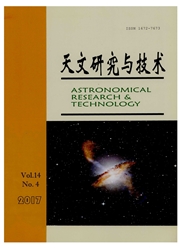

 中文摘要:
中文摘要:
太阳望远镜采用全开式圆顶有许多好处,但是此时风对望远镜产生比较大的扰动。为了减少风对望远镜的影响,设计了阻导风板,并在实际应用中得到了很好的结果。全面介绍了阻导风板的原理、结构,并给出了设计要点及在1m红外太阳望远镜(NewVacuum Solar Telescope,NVST)上的实测结果。
 英文摘要:
英文摘要:
Solar Telescopes often work without domes, but are set up near large water surfaces such as those of seas or lakes. Such a strategy keeps good seeings at the sites, but on the other hand, the air flow between land and water may cause vibrations of telescopes. To reduce the negative effects, we have designed and installed a set of Hindering and Steering Windscreens for our NVST ( New Vacuum Solar Telescope). We report in this paper key design points and encouraging results. Our H-S Windscreen consists of three parts: (1) The first is a wind deflector consisting of many rectangular lamellas. Long edges of a lamella are flatly set on the supporting frame, and the plane surface of the lamella has a specific angle from the horizontal level decided by numerical simulations. The material for lamella is of low thermal conductivity to avoid strong heat exchange. (2) The second is a curved wind baffle the height of which is adjustable according to the telescope pointing. (3) The third is a circular supporting frame, which turns around according to wind directions. The H-S Windscreens have been put into use with the NVST at the Fuxian Lake Solar Observing Station since August 2010. We give some test results. The H-S Windscreen can reduce the wind force by an order of magnitude and the wind-speed variation. The design of the NVST windscreen is thus successful in reducing the effect of wind force on the telescope and in increasing observation time.
 同期刊论文项目
同期刊论文项目
 同项目期刊论文
同项目期刊论文
 期刊信息
期刊信息
